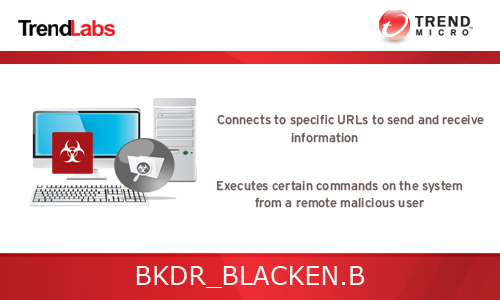BKDR_BLACKEN.C
Backdoor.Win32.Fonten.y (Kaspersky); Win32:Blackenergy-Y [Trj] (Avast);
Windows


Threat Type: Backdoor
Destructiveness: No
Encrypted: Yes
In the wild: Yes
OVERVIEW
Dropped by other malware
To get a one-glance comprehensive view of the behavior of this Backdoor, refer to the Threat Diagram shown below.

This backdoor may be dropped by other malware.
It executes commands from a remote malicious user, effectively compromising the affected system. It connects to a website to send and receive information.
TECHNICAL DETAILS
110592 bytes
EXE
Yes
20 Jan 2016
Connects to URLs/IPs, Compromises system security
Arrival Details
This backdoor may be dropped by the following malware:
- X2KM_FONTEN.DAM
Installation
This backdoor drops the following copies of itself into the affected system:
- %AppDataLocal%\FONTCACHE.DAT
This is executed as follows: rundll32.exe "%AppDataLocal%\FONTCACHE.DAT",#1
(Note: %AppDataLocal% is the Application Data folder found in Local Settings, where it is usually C:\Documents and Settings\{user name}\Local Settings\Application Data on Windows 2000, Windows Server 2003, and Windows XP (32- and 64-bit); C:\Users\{user name}\AppData\Local on Windows Vista (32- and 64-bit), Windows 7 (32- and 64-bit), Windows 8 (32- and 64-bit), Windows 8.1 (32- and 64-bit), Windows Server 2008, and Windows Server 2012.)
It drops the following non-malicious file:
- %User Profile%\NTUSER.LOG
(Note: %User Profile% is the current user's profile folder, which is usually C:\Documents and Settings\{user name} on Windows 2000, XP, and Server 2003, or C:\Users\{user name} on Windows Vista and 7.)
It adds the following processes:
- iexplore.exe
It injects codes into the following process(es):
- iexplore.exe
Autostart Technique
This backdoor drops the following file(s) in the Windows Startup folder to enable its automatic execution at every system startup:
- %User Startup%\{GUID}.lnk
(Note: %User Startup% is the current user's Startup folder, which is usually C:\Documents and Settings\{user}\Start Menu\Programs\Startup on Windows 2000 and XP, and C:\Documents and Settings\{User name}\Start Menu\Programs\Startup on Windows Vista, 7, and 8.)
Other System Modifications
This backdoor adds the following registry entries:
HKCU\Software\Microsoft\
Internet Explorer\PhishingFilter
Enabled = "0"
HKEY_CURRENT_USER\Software\Microsoft\
Windows\CurrentVersion\Internet Settings\
CACHE
Persistent = "0"
HKEY_CURRENT_USER\Software\Microsoft\
Internet Explorer\TabbedBrowsing
WarnOnClose = "0"
HKEY_CURRENT_USER\Software\Microsoft\
Internet Explorer\TabbedBrowsing
WarnOnCloseAdvanced = "0"
HKEY_CURRENT_USER\Software\Microsoft\
Internet Explorer\Main
DisableFirstRunCustomize = "1"
HKEY_CURRENT_USER\Software\Microsoft\
Internet Explorer\Recovery
NoReopenLastSession = "1"
HKEY_CURRENT_USER\Software\Microsoft\
Internet Explorer\Main
NoProtectedModeBanner = "1"
HKEY_CURRENT_USER\Software\Microsoft\
Internet Explorer\InformationBar
FirstTime = "0"
Backdoor Routine
This backdoor executes the following commands from a remote malicious user:
- Uninstall
- Execute shell command
- Download a file
- Load plugin
It connects to the following websites to send and receive information:
- http://{BLOCKED}.{BLOCKED}.254.114/Microsoft/Update/KC074913.php
- sends the following: b_id={computer name}_{ID}&b_gen=release&b_ver=2.3&os_v={OS version}&os_type={OS type}
NOTES:
It has the capability to capture packets and sniff networks.
SOLUTION
9.800
Step 1
Before doing any scans, Windows XP, Windows Vista, and Windows 7 users must disable System Restore to allow full scanning of their computers.
Step 2
Remove the malware/grayware file that dropped/downloaded BKDR_BLACKEN.C. (Note: Please skip this step if the threat(s) listed below have already been removed.)
- X2KM_FONTEN.B
Step 3
Note that not all files, folders, and registry keys and entries are installed on your computer during this malware's/spyware's/grayware's execution. This may be due to incomplete installation or other operating system conditions. If you do not find the same files/folders/registry information, please proceed to the next step.
Step 4
Restart in Safe Mode
Step 5
Delete this registry value
Important: Editing the Windows Registry incorrectly can lead to irreversible system malfunction. Please do this step only if you know how or you can ask assistance from your system administrator. Else, check this Microsoft article first before modifying your computer's registry.
- In HKEY_CURRENT_USER\Software\Microsoft\Internet Explorer\PhishingFilter
- Enabled = "0"
- Enabled = "0"
- In HKEY_CURRENT_USER\Software\Microsoft\Windows\CurrentVersion\Internet Settings\CACHE
- Persistent = "0"
- Persistent = "0"
- In HKEY_CURRENT_USER\Software\Microsoft\Internet Explorer\TabbedBrowsing
- WarnOnClose = "0"
- WarnOnClose = "0"
- In HKEY_CURRENT_USER\Software\Microsoft\Internet Explorer\TabbedBrowsing
- WarnOnCloseAdvanced = "0"
- WarnOnCloseAdvanced = "0"
- In HKEY_CURRENT_USER\Software\Microsoft\Internet Explorer\Main
- DisableFirstRunCustomize = "1"
- DisableFirstRunCustomize = "1"
- In HKEY_CURRENT_USER\Software\Microsoft\Internet Explorer\Recovery
- NoReopenLastSession = "1"
- NoReopenLastSession = "1"
- In HKEY_CURRENT_USER\Software\Microsoft\Internet Explorer\Main
- NoProtectedModeBanner = "1"
- NoProtectedModeBanner = "1"
- In HKEY_CURRENT_USER\Software\Microsoft\Internet Explorer\InformationBar
- FirstTime = "0"
- FirstTime = "0"
Step 6
Search and delete this file
- %User Startup%\{GUID}.lnk
Step 7
Restart in normal mode and scan your computer with your Trend Micro product for files detected as BKDR_BLACKEN.C. If the detected files have already been cleaned, deleted, or quarantined by your Trend Micro product, no further step is required. You may opt to simply delete the quarantined files. Please check this Knowledge Base page for more information.
Did this description help? Tell us how we did.

